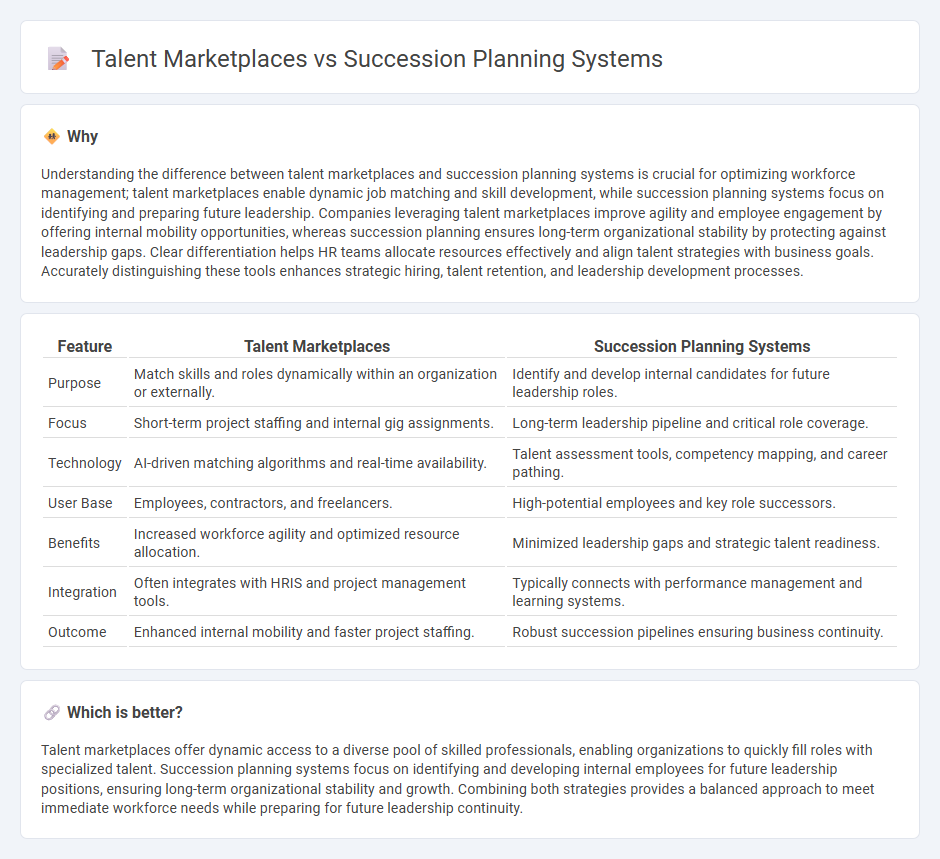
Talent marketplaces enable organizations to dynamically match employees with internal opportunities based on skills and career aspirations, fostering agility and engagement. Succession planning systems focus on identifying and developing future leaders to ensure organizational continuity and minimize talent gaps. Explore how integrating both solutions can enhance workforce strategy and drive business success.
Why it is important
Understanding the difference between talent marketplaces and succession planning systems is crucial for optimizing workforce management; talent marketplaces enable dynamic job matching and skill development, while succession planning systems focus on identifying and preparing future leadership. Companies leveraging talent marketplaces improve agility and employee engagement by offering internal mobility opportunities, whereas succession planning ensures long-term organizational stability by protecting against leadership gaps. Clear differentiation helps HR teams allocate resources effectively and align talent strategies with business goals. Accurately distinguishing these tools enhances strategic hiring, talent retention, and leadership development processes.
Comparison Table
| Feature | Talent Marketplaces | Succession Planning Systems |
|---|---|---|
| Purpose | Match skills and roles dynamically within an organization or externally. | Identify and develop internal candidates for future leadership roles. |
| Focus | Short-term project staffing and internal gig assignments. | Long-term leadership pipeline and critical role coverage. |
| Technology | AI-driven matching algorithms and real-time availability. | Talent assessment tools, competency mapping, and career pathing. |
| User Base | Employees, contractors, and freelancers. | High-potential employees and key role successors. |
| Benefits | Increased workforce agility and optimized resource allocation. | Minimized leadership gaps and strategic talent readiness. |
| Integration | Often integrates with HRIS and project management tools. | Typically connects with performance management and learning systems. |
| Outcome | Enhanced internal mobility and faster project staffing. | Robust succession pipelines ensuring business continuity. |
Which is better?
Talent marketplaces offer dynamic access to a diverse pool of skilled professionals, enabling organizations to quickly fill roles with specialized talent. Succession planning systems focus on identifying and developing internal employees for future leadership positions, ensuring long-term organizational stability and growth. Combining both strategies provides a balanced approach to meet immediate workforce needs while preparing for future leadership continuity.
Connection
Talent marketplaces streamline internal mobility by matching employee skills with open roles, enhancing workforce agility and retention. Succession planning systems identify critical positions and develop internal candidates by analyzing performance and potential data. Integrating these tools enables organizations to proactively fill key roles, reduce hiring costs, and ensure leadership continuity.
Key Terms
Internal Mobility
Succession planning systems primarily identify and prepare high-potential employees for future leadership roles within an organization, emphasizing long-term internal mobility strategies. Talent marketplaces dynamically match employees to short- and mid-term project opportunities, fostering greater workforce agility and real-time internal mobility. Explore how integrating these approaches can enhance your company's talent development and retention.
Skill Matching
Succession planning systems strategically identify and develop internal candidates by assessing leadership potential and role readiness, while talent marketplaces emphasize real-time skill matching by connecting employees with projects based on current skills and development goals. Talent marketplaces dynamically adapt to workforce needs, leveraging AI-driven algorithms for precise skill alignment, promoting agility and personalized career growth. Discover how integrating both approaches can enhance your organization's talent strategy and employee engagement.
Leadership Pipeline
Succession planning systems strategically identify and develop internal leaders to ensure a robust leadership pipeline, focusing on long-term organizational stability. Talent marketplaces dynamically match available internal talent with emerging leadership roles, accelerating development and fostering agility within the leadership pipeline. Explore how integrating these approaches can optimize leadership readiness and drive business success.
Source and External Links
Best Succession Planning Tools & Software - ExecOnline - Succession planning software typically features talent identification and assessment, leadership development planning, and reporting/analytics to streamline and optimize succession processes within integrated HR platforms.
Best Succession Planning Software in 2025 | TalentGuard - TalentGuard's software helps organizations identify and develop future leaders, ensuring smooth leadership transitions, talent retention, risk mitigation, and business continuity by strategically preparing key roles.
Succession Planning Software - Dayforce - Dayforce provides succession planning tools that prepare organizations for turnover by identifying suitable employees for key roles, enabling coverage plans, career growth, and enabling informed, timely decisions with real-time HR data.
 dowidth.com
dowidth.com